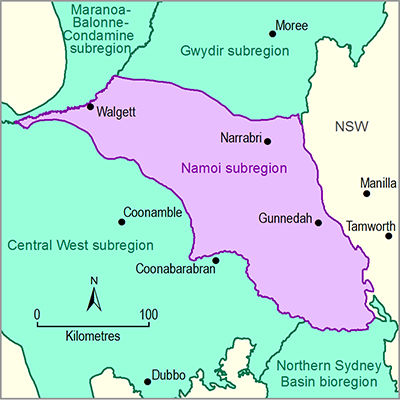- Home
- Assessments
- Bioregional Assessment Program
- Namoi subregion
- 2.6.2 Groundwater numerical modelling for the Namoi subregion
- 2.6.2.4 Boundary and initial conditions
Summary
The eastern boundary of the Namoi subregion groundwater model is defined by the Hunter-Mooki Thrust Fault and is assumed to be impermeable. The northern boundary is also assumed to be a no-flow boundary as it is parallel to groundwater-flow direction in the Great Artesian Basin. Elsewhere the model domain extends beyond the subregion boundary in order to minimise boundary effects in the model results, and general-head boundary conditions are used.
The model’s land surface is subject to recharge due to rainfall, overbank flooding and irrigation. Recharge varies spatially and temporally. The land surface is also subject to a depth-dependent evapotranspiration boundary condition.
All major rivers, along with some minor reaches, are represented in the model. These represent the points at which the groundwater model interacts with the surface water model. This is a two-way exchange of water between models: when the river stage is above the watertable the river can leak to the groundwater, when the watertable is above the river stage the groundwater model will contribute baseflow to the river.
A total of 11,785 groundwater extraction bores are included in the model. Each is assumed to extract water according to its full entitlement.

Product Finalisation date
- 2.6.2.1 Methods
- 2.6.2.2 Review of existing models
- 2.6.2.3 Model development
- 2.6.2.4 Boundary and initial conditions
- 2.6.2.5 Implementation of the coal resource development pathway
- 2.6.2.6 Parameterisation
- 2.6.2.7 Observations and predictions
- 2.6.2.8 Uncertainty analysis
- 2.6.2.9 Limitations
- Citation
- Currency of scientific results
- Acknowledgements
- Contributors to the Technical Programme
- About this technical product
